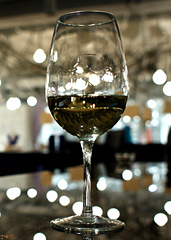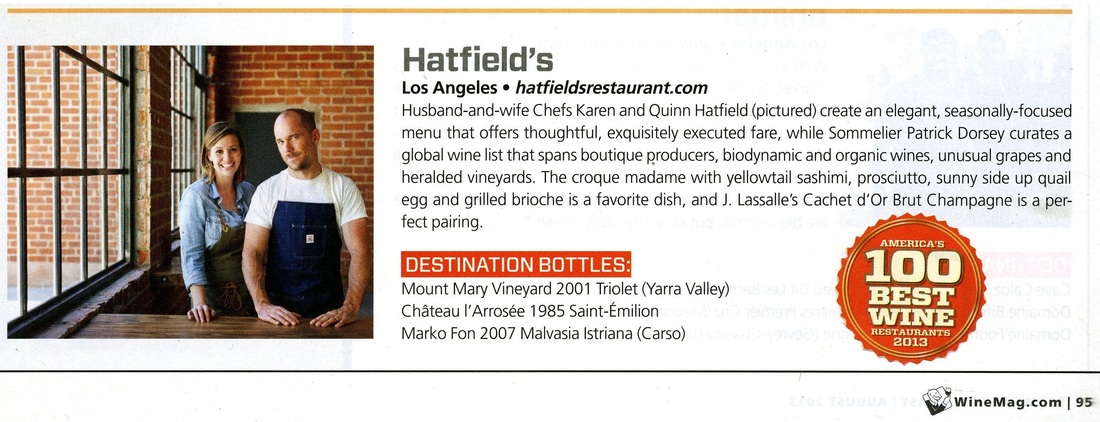Vinissimo Selection. Quality. Typicity. Pleasure. ....not all wines are created equal.
I am personally labelling gutturnio superiore Casale Grande. Quality control. twitter.com/NicRigamonti/s…
— Nicolas Rigamonti (@NicRigamonti) May 4, 2013
Wine Enthusiast (August 2013) | Destination Wine: Marko Fon
Food Arts
Lauding Lambrusco
Jeffery Lindenmuth / September 2012
Emilia-Romagna’s versatile varietal earns some hard-won respect from sommeliers.
A new generation of American diners appears prepared to give Lambrusco a fresh start. And sommeliers who clamor for lower alcohol, food-friendly, and affordable wines are ready to oblige. There are many facets to DOC Lambrusco: The wines range from deep red to rosé, from generously fizzy to lightly frizzantino, and may be secco (dry) or amabile (off-dry), in addition to sweeter styles. While it can be incredibly challenging to sell a wine that has zero name recognition among restaurant diners, Lambrusco is even less fortunate. Ever since Banfi Vintners’ Riunite Lambrusco attained the position of America’s number one imported wine in 1976, the Lambrusco wines of Italy’s Emilia-Romagna and Lombardy regions have been members of a dubious club—wines that serious wine drinkers avoid.
“Emilia-Romagna was a region with many big co-ops, willing to make and sell whatever wine you wanted. Riunite created a wine and did a very good job,” says James Koch of California’s JK Imports, who began importing small producer, secco Lambrusco in 1995. “For 10 years, until about 2005, I was literally laughed at.” During that same period, other culinary traditions of Emilia-Romagna—Prosciutto di Parma and Parmigiano-Reggiano—established proud reputations in the United States. Now, it may finally be Lambrusco’s turn at the table.
“The people who are enjoying Lambrusco either don’t know anything about wine and want something friendly or are very savvy. It’s all the in-between people who think they know Lambrusco who are the most apprehensive,” says Jim Kennedy, partner/wine consultant at Uva Enoteca in San Francisco. With a carne selection including a rich variety of prosciutto, mortadella, salame, speck, and bresaola, Uva embraces one of the key signatures driving the Lambrusco revival. “With cured meats and cheese, it’s a great wine because of the low tannins and high acidity. We carry Pronto Lambrusco and actually have trouble keeping it in stock. Few wines are as versatile as a slightly chilled, fizzy red,” beams Kennedy.
Few wines are as challenging to categorize on a restaurant wine list, too. Koch says he prefers to see quality Lambrusco in the red wine section because they are red wines first. Being frizzante, with about half the fizz of spumante wines, he fears some consumers will declare them flat. Then again, a frothy red wine served at Champagne temperature (below 45˚F) defies most red wine expectations. For most restaurants, Lambrusco seems at home filed under “sparkling,” often served in a red wine glass, with ample explanation.
At Coppa in Boston, general manager Mary Edes includes several Lambrusco wines in the sparkling section of her list of about 50 wines, all under $100. Currently on offer are Medici Ermete Quercioli Regguabi, a dolce style ($25), Cavicchioli Col Sassoso ($40), and Mionetto il Lambrusco ($30), an ambitious assortment for a wine best consumed within a year of release. “It was a reaction to our salumi, because these wines are ideal with fatty, salty cured meats. But we’re also a big industry hangout, and focused on value, so we have the right audience,” says Edes.
Through dedicated staff education and salesmanship, Edes says she has built an eclectic following for Lambrusco. “It’s both the person who wants a sweeter, approachable red wine and the guy who orders the pig’s ear terrine. We get a lot of people hooked on it, and they keep coming back searching for it,” she says. Indeed, the bigger challenge has now become maintaining a steady supply of quality Lambrusco at Coppa.
At Maialino, part of New York City’s Union Square Hospitality Group, wine director Liz Nicholson offers Lini Lambrusco Labrusca Rosso by the glass, quartino, or bottle ($9, $15, $36) listed under Bollicine (“bubbles”), selling between two and three cases each week. “It’s really getting popular among 20-something wine drinkers. They don’t even know the name, but they want the wine that’s red, sparkling, and Italian. For someone who has been drinking wine for 30 years, that stigma of Lambrusco is much harder to overcome,” she says. Fellow USHG wine directors have also experimented with dry Lambrusco, offering it by the glass at Gramercy Tavern and Union Square Cafe, especially in the warmer months when chilled red is an easier sell.
In addition to Lambrusco with salumi, Nicholson pairs the wines with spicy tomato dishes, including bucatini all’amatriciana, and lamb chops with black pepper. “Once you begin to look at the variety within real Lambrusco, the big range of fizz and acid and tannins, I think it fits into every portion of the meal. I like rosé as an apéritif, dry red with food, and the sweeter styles with dessert, especially fresh peaches and nectarines.”
According to Rico Grootveldt, export manager for Chiarli 1860, the wines of Lambrusco Grasparossa Di Castelvetro DOC are the driest and most powerful. “You must remember that the food we have around Modena is not Mediterranean, but rather fatty and rich. So you’ll find these wines that are full-bodied Lambruscos are a good partner with barbecue, Brazilian churrascaria, and Argentine steak and asado,” says Grootveldt.
With six approved grape varieties and five DOC regions, sorting out the new wave of quality Lambrusco, crafted in dry and off-dry styles, from the industrial wines can be a challenge. According to Koch, the alcohol level is the fastest and easiest way to deduce the difference. “Real Lambrusco has a minimum alcohol of 10.5 percent by DOC standards. When it’s less than that, you are sampling your grandmother’s Lambrusco,” he says. While it’s unlikely to rival the 2 million cases of Riunite wine consumed annually in the United States, Banfi, too, has moved into small-production, dry Lambrusco with Albinea Canali Ottocentonero Lambrusco, offered primarily to restaurants.
Still, any wine director who chooses to suggest a Lambrusco wine should probably be prepared for sneers, giggles, possibly even a rendition of the catchy disco-era “Riunite on ice, Riunite so nice.” Koch has heard it all. “I tell them, forget what you know of Lambrusco. It’s not what you think,” he says.
Emilia-Romagna’s versatile varietal earns some hard-won respect from sommeliers.
A new generation of American diners appears prepared to give Lambrusco a fresh start. And sommeliers who clamor for lower alcohol, food-friendly, and affordable wines are ready to oblige. There are many facets to DOC Lambrusco: The wines range from deep red to rosé, from generously fizzy to lightly frizzantino, and may be secco (dry) or amabile (off-dry), in addition to sweeter styles. While it can be incredibly challenging to sell a wine that has zero name recognition among restaurant diners, Lambrusco is even less fortunate. Ever since Banfi Vintners’ Riunite Lambrusco attained the position of America’s number one imported wine in 1976, the Lambrusco wines of Italy’s Emilia-Romagna and Lombardy regions have been members of a dubious club—wines that serious wine drinkers avoid.
“Emilia-Romagna was a region with many big co-ops, willing to make and sell whatever wine you wanted. Riunite created a wine and did a very good job,” says James Koch of California’s JK Imports, who began importing small producer, secco Lambrusco in 1995. “For 10 years, until about 2005, I was literally laughed at.” During that same period, other culinary traditions of Emilia-Romagna—Prosciutto di Parma and Parmigiano-Reggiano—established proud reputations in the United States. Now, it may finally be Lambrusco’s turn at the table.
“The people who are enjoying Lambrusco either don’t know anything about wine and want something friendly or are very savvy. It’s all the in-between people who think they know Lambrusco who are the most apprehensive,” says Jim Kennedy, partner/wine consultant at Uva Enoteca in San Francisco. With a carne selection including a rich variety of prosciutto, mortadella, salame, speck, and bresaola, Uva embraces one of the key signatures driving the Lambrusco revival. “With cured meats and cheese, it’s a great wine because of the low tannins and high acidity. We carry Pronto Lambrusco and actually have trouble keeping it in stock. Few wines are as versatile as a slightly chilled, fizzy red,” beams Kennedy.
Few wines are as challenging to categorize on a restaurant wine list, too. Koch says he prefers to see quality Lambrusco in the red wine section because they are red wines first. Being frizzante, with about half the fizz of spumante wines, he fears some consumers will declare them flat. Then again, a frothy red wine served at Champagne temperature (below 45˚F) defies most red wine expectations. For most restaurants, Lambrusco seems at home filed under “sparkling,” often served in a red wine glass, with ample explanation.
At Coppa in Boston, general manager Mary Edes includes several Lambrusco wines in the sparkling section of her list of about 50 wines, all under $100. Currently on offer are Medici Ermete Quercioli Regguabi, a dolce style ($25), Cavicchioli Col Sassoso ($40), and Mionetto il Lambrusco ($30), an ambitious assortment for a wine best consumed within a year of release. “It was a reaction to our salumi, because these wines are ideal with fatty, salty cured meats. But we’re also a big industry hangout, and focused on value, so we have the right audience,” says Edes.
Through dedicated staff education and salesmanship, Edes says she has built an eclectic following for Lambrusco. “It’s both the person who wants a sweeter, approachable red wine and the guy who orders the pig’s ear terrine. We get a lot of people hooked on it, and they keep coming back searching for it,” she says. Indeed, the bigger challenge has now become maintaining a steady supply of quality Lambrusco at Coppa.
At Maialino, part of New York City’s Union Square Hospitality Group, wine director Liz Nicholson offers Lini Lambrusco Labrusca Rosso by the glass, quartino, or bottle ($9, $15, $36) listed under Bollicine (“bubbles”), selling between two and three cases each week. “It’s really getting popular among 20-something wine drinkers. They don’t even know the name, but they want the wine that’s red, sparkling, and Italian. For someone who has been drinking wine for 30 years, that stigma of Lambrusco is much harder to overcome,” she says. Fellow USHG wine directors have also experimented with dry Lambrusco, offering it by the glass at Gramercy Tavern and Union Square Cafe, especially in the warmer months when chilled red is an easier sell.
In addition to Lambrusco with salumi, Nicholson pairs the wines with spicy tomato dishes, including bucatini all’amatriciana, and lamb chops with black pepper. “Once you begin to look at the variety within real Lambrusco, the big range of fizz and acid and tannins, I think it fits into every portion of the meal. I like rosé as an apéritif, dry red with food, and the sweeter styles with dessert, especially fresh peaches and nectarines.”
According to Rico Grootveldt, export manager for Chiarli 1860, the wines of Lambrusco Grasparossa Di Castelvetro DOC are the driest and most powerful. “You must remember that the food we have around Modena is not Mediterranean, but rather fatty and rich. So you’ll find these wines that are full-bodied Lambruscos are a good partner with barbecue, Brazilian churrascaria, and Argentine steak and asado,” says Grootveldt.
With six approved grape varieties and five DOC regions, sorting out the new wave of quality Lambrusco, crafted in dry and off-dry styles, from the industrial wines can be a challenge. According to Koch, the alcohol level is the fastest and easiest way to deduce the difference. “Real Lambrusco has a minimum alcohol of 10.5 percent by DOC standards. When it’s less than that, you are sampling your grandmother’s Lambrusco,” he says. While it’s unlikely to rival the 2 million cases of Riunite wine consumed annually in the United States, Banfi, too, has moved into small-production, dry Lambrusco with Albinea Canali Ottocentonero Lambrusco, offered primarily to restaurants.
Still, any wine director who chooses to suggest a Lambrusco wine should probably be prepared for sneers, giggles, possibly even a rendition of the catchy disco-era “Riunite on ice, Riunite so nice.” Koch has heard it all. “I tell them, forget what you know of Lambrusco. It’s not what you think,” he says.
Angeleno | July 2012 | Viva Italia
Italian wines are huge right now, and not just at Italian restaurants. Three of our favorite experts tell us what we should be drinking now.
"Though most of my summer wines come in varying shades of pink, my fridge in July is usually full of vermentino. I'm particularly fond of Davide Neri's Groppolo from the hills of southern Liguria. A little bit of stone fruit, a pinch of lemon, a touch of fresh herbs, brilliant acidity and just the right amount of weight make for a dangerously drinkable wine."
"Though most of my summer wines come in varying shades of pink, my fridge in July is usually full of vermentino. I'm particularly fond of Davide Neri's Groppolo from the hills of southern Liguria. A little bit of stone fruit, a pinch of lemon, a touch of fresh herbs, brilliant acidity and just the right amount of weight make for a dangerously drinkable wine."
Your browser does not support viewing this document. Click here to download the document.
PIZZA WEEK

The Best Pizza-Friendly Wines, Picked by the Pros
"In honor of Pizza Week, we are going straight to the trenches to ask the beverage directors at some of the country's most revered pizza joints (and one four-star Italian restaurant, why not?) about how they fell in love with pizza, where they eat it and, most importantly—what they drink with it.
Here now, please meet...Taylor Parsons of Pizzeria Mozza in Los Angeles,...and the fancy wrench in the line-up, Jeff Porter of Del Posto in New York....
"In honor of Pizza Week, we are going straight to the trenches to ask the beverage directors at some of the country's most revered pizza joints (and one four-star Italian restaurant, why not?) about how they fell in love with pizza, where they eat it and, most importantly—what they drink with it.
Here now, please meet...Taylor Parsons of Pizzeria Mozza in Los Angeles,...and the fancy wrench in the line-up, Jeff Porter of Del Posto in New York....
Jeff Porter | Wine Director, Del Posto, New York

When did you first realize you loved pizza?
My first cognitive love of pizza came from this place is in College Station, Texas (home of Texas A & M). I lived there from age two to five. It was this place called Mama's Pizza. The only things I can remember about it today are the jukebox, pool tables, and the smell. That smell of greasy cheese and pepperoni (which was probably plastic) and that thick, yeasty dough. I LOVED IT! Four slices of pepperoni, mushroom, and black olive...that was my jam!
Best pizza in NYC?
The NYC pizza experience is a long, continual path and I am torn between Motorino, Keste, Franny's and Roberta's. I like them each for different reasons but if it comes down to just the pie itself I'd have to go with Franny's. Your go to pie? I have two: Tomato, basil and Buffalo Mozzarella, and when I need my weekly salt intake adjusted to its zenith I go with tomato, anchovies, capers, olives, chilies and parmigiano reggiano.
Your go-to pizza wines?
... 3) Nero di troia. I am currently stoked about Cefalicchio's Puglia Rosso di Canosa. The wine is plump, inky, full of dark fruits mixed with leather and dust, firm tannins and bright acidity. This is for when I have to hit up the "Meat Lovers" pizza.
Any weird pairings?
I love Margaritas with my pizza. I am a bit of an acid hound so I tend to make my Margaritas quite tart, and I love the freshness of the drink with a classic Margarita pizza in the summer.
[Photo: Jeff Porter]
My first cognitive love of pizza came from this place is in College Station, Texas (home of Texas A & M). I lived there from age two to five. It was this place called Mama's Pizza. The only things I can remember about it today are the jukebox, pool tables, and the smell. That smell of greasy cheese and pepperoni (which was probably plastic) and that thick, yeasty dough. I LOVED IT! Four slices of pepperoni, mushroom, and black olive...that was my jam!
Best pizza in NYC?
The NYC pizza experience is a long, continual path and I am torn between Motorino, Keste, Franny's and Roberta's. I like them each for different reasons but if it comes down to just the pie itself I'd have to go with Franny's. Your go to pie? I have two: Tomato, basil and Buffalo Mozzarella, and when I need my weekly salt intake adjusted to its zenith I go with tomato, anchovies, capers, olives, chilies and parmigiano reggiano.
Your go-to pizza wines?
... 3) Nero di troia. I am currently stoked about Cefalicchio's Puglia Rosso di Canosa. The wine is plump, inky, full of dark fruits mixed with leather and dust, firm tannins and bright acidity. This is for when I have to hit up the "Meat Lovers" pizza.
Any weird pairings?
I love Margaritas with my pizza. I am a bit of an acid hound so I tend to make my Margaritas quite tart, and I love the freshness of the drink with a classic Margarita pizza in the summer.
[Photo: Jeff Porter]
Taylor Parsons | Beverage Director, Mozza Restaurants, Los Angeles

When did you first realize you loved pizza?
I'm an equal-opportunity pizza lover: great pizza, crappy pizza, cold pizza, hot pizza, stuffed pizza, thin crust. There's just something about bread, sauce and cheese that is all primal deliciousness. But it was Nancy [Silverton] who taught me that pizza is ultimately about the structure and flavor of the crust.
Favorite pizza in LA?
Professional bias aside, I think Mozza's pizzas are utterly fantastic. It's not about rigid adherence to any one tradition (e.g. Neapolitan, etc.), nor is it about crazy excesses like that Crown Crust madness going on at Pizza Hut. It's about quality ingredients and a touch of chefly ingenuity.
Your favorite pie?
Mozza's Tomato Pizza with Di Napoli tomatoes. No cheese, just hand-pureed sweet organic tomatoes, Sicilian oregano, Maldon salt and a drizzle of extra virgin olive oil. Blow-your-mind good.
Your go-to pizza wines?
With our funghi misti pizza, for example, you can play off the funk of the taleggio, the earthiness of the mushrooms, and the herbal intensity of the thyme. Schiava from the Alto Adige just shines with that pizza...particularly from producers like Franz Gojer...and La Distesa's Verdicchio "Terre Silvate" 2010 from Le Marche has got that briny lemon and ocean-spray thing going on, and it absolutely rocks with our Ipswich clam pizza and anchovy pizza.
[Photo: Taylor Parsons]
- Eater.com | Pizza Week
I'm an equal-opportunity pizza lover: great pizza, crappy pizza, cold pizza, hot pizza, stuffed pizza, thin crust. There's just something about bread, sauce and cheese that is all primal deliciousness. But it was Nancy [Silverton] who taught me that pizza is ultimately about the structure and flavor of the crust.
Favorite pizza in LA?
Professional bias aside, I think Mozza's pizzas are utterly fantastic. It's not about rigid adherence to any one tradition (e.g. Neapolitan, etc.), nor is it about crazy excesses like that Crown Crust madness going on at Pizza Hut. It's about quality ingredients and a touch of chefly ingenuity.
Your favorite pie?
Mozza's Tomato Pizza with Di Napoli tomatoes. No cheese, just hand-pureed sweet organic tomatoes, Sicilian oregano, Maldon salt and a drizzle of extra virgin olive oil. Blow-your-mind good.
Your go-to pizza wines?
With our funghi misti pizza, for example, you can play off the funk of the taleggio, the earthiness of the mushrooms, and the herbal intensity of the thyme. Schiava from the Alto Adige just shines with that pizza...particularly from producers like Franz Gojer...and La Distesa's Verdicchio "Terre Silvate" 2010 from Le Marche has got that briny lemon and ocean-spray thing going on, and it absolutely rocks with our Ipswich clam pizza and anchovy pizza.
[Photo: Taylor Parsons]
- Eater.com | Pizza Week
Vin It to Win It
Really Good, Really Rare Wine

"Ah, rare wine...
So tasty. So impressive to other people. So hard to obtain.
Wait—scratch that last one.
That’s because today—to the dismay of goateed sommeliers all across Southern
California—we bring you word of a place that is going to make impossible-to-find wine bottles a lot less impossible to find.
Miles from Sideways, this is your moment to get excited...
Say hello to Vinissimo, a secret wine shop that, after years of supplying wines to some of our city’s top restaurants, is now opening itself up to the public.
You’ll have to make an appointment, and you’ll have to get yourself to an unassuming little storefront in Pasadena, but we think it’s worth your trouble the next time you’re planning an all-stops-out date night at home, or want to convince a wine-loving producer to invest in your Terms of Endearment-meets-Zombieland pitch.
The folks at Vinissimo have been getting the top Spanish and Italian wines to your tables at Campanile, Cube, Dominick’s and the Mozzas for years—and now, by removing the middleman, your wine cellar (/rack on your kitchen counter) is next.
Come in, look around, ask questions and buy a couple bottles for your big night.
So it’s similar to your secret-vodka-shop arrangement."
Read more: http://www.urbandaddy.com/articles/print/10806#ixzz2SpMNN7zJ
So tasty. So impressive to other people. So hard to obtain.
Wait—scratch that last one.
That’s because today—to the dismay of goateed sommeliers all across Southern
California—we bring you word of a place that is going to make impossible-to-find wine bottles a lot less impossible to find.
Miles from Sideways, this is your moment to get excited...
Say hello to Vinissimo, a secret wine shop that, after years of supplying wines to some of our city’s top restaurants, is now opening itself up to the public.
You’ll have to make an appointment, and you’ll have to get yourself to an unassuming little storefront in Pasadena, but we think it’s worth your trouble the next time you’re planning an all-stops-out date night at home, or want to convince a wine-loving producer to invest in your Terms of Endearment-meets-Zombieland pitch.
The folks at Vinissimo have been getting the top Spanish and Italian wines to your tables at Campanile, Cube, Dominick’s and the Mozzas for years—and now, by removing the middleman, your wine cellar (/rack on your kitchen counter) is next.
Come in, look around, ask questions and buy a couple bottles for your big night.
So it’s similar to your secret-vodka-shop arrangement."
Read more: http://www.urbandaddy.com/articles/print/10806#ixzz2SpMNN7zJ

